It’s hard to fathom how they did it, but the ancient Egyptians built some of the greatest structures in history.
The best-known ones are immense pyramids and Egyptian Temples, but these are not the only famous buildings in Egypt. The Muslim conquest of the region tremendously changed the architectural landscape, especially in Cairo.
Many people wonder how they did it. Some conspiracy theorists even claim that human beings couldn’t have constructed these monumental structures without the use of modern machines.
Because they had a lot of practice (and some failed experiments as you’ll soon discover), we believe an immense amount of manpower erected the most famous pyramids in Egypt.
Let’s take a closer look at some of the most remarkable ones.
1. Great Pyramid of Giza
The Great Pyramid of Giza is one of the 3 monumental pyramids that dominate the Giza Plateau just outside of Cairo. It’s the largest of the 3 pyramids that were constructed here by a family of builders who lived during the 4th Dynasty, a period also known as the “Golden Age” of the Old Kingdom. This pyramid is believed to have been commissioned by Pharaoh Khufu.
It’s also the oldest of the 3 as it was constructed in the 26th century B.C. and probably took around 27 years to build.
That’s an incredible timeframe for such an enormous building that has a square base with a length of 230.33 meters (756 feet). It’s also the oldest of the 7 Wonders of the Ancient World and the only one in that list that still stands today.

2. Pyramid of Djoser
The Pyramid of Djoser is an even older structure and a so-called “Step Pyramid.” It was constructed by a Pharoah with the same name who lived during the 3rd dynasty in the 27th century B.C. It’s located in the immense Saqqara Necropolis, the burial ground of the ancient Egyptian city of Memphis, just south of Cairo.

It’s one of the most famous pyramids in Egypt because it’s considered to be the oldest monumental structure that was constructed in ancient Egypt.
It has a base of 109 × 121 meters (358 × 397 feet) and originally stood 62.5 meters (205 feet) tall. It’s the predecessor of the smooth-faced pyramids we all know so well.
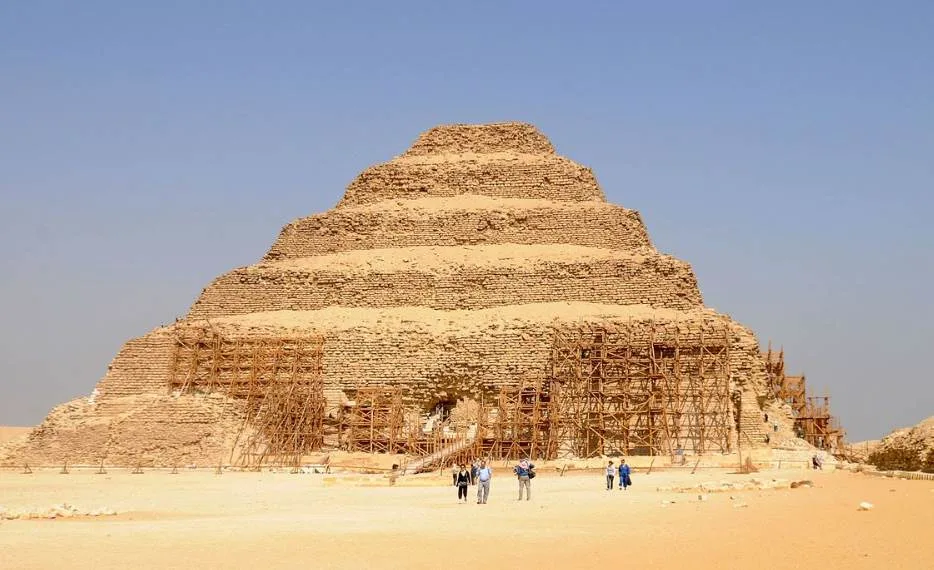
3. Meidum Pyramid
The Medium Pyramid is located in Dahshur, just a bit further south of Cairo than the Pyramid of Djoser and about 72 kilometers (45 miles) south of the modern-day city. It’s believed to be the second pyramid that was constructed and commissioned by Pharaoh Huni, the final Pharaoh of the Third Dynasty, and continued by Sneferu, the founder of the 4th dynasty.
What’s remarkable about this pyramid is that they started out building a step pyramid but changed their approach halfway in an attempt to turn it into a smooth-faced pyramid.
Construction errors in combination with this drastic change resulted in a partial collapse. Today, only the interior structure of the top section and the ruined steps of the lower section are visible.
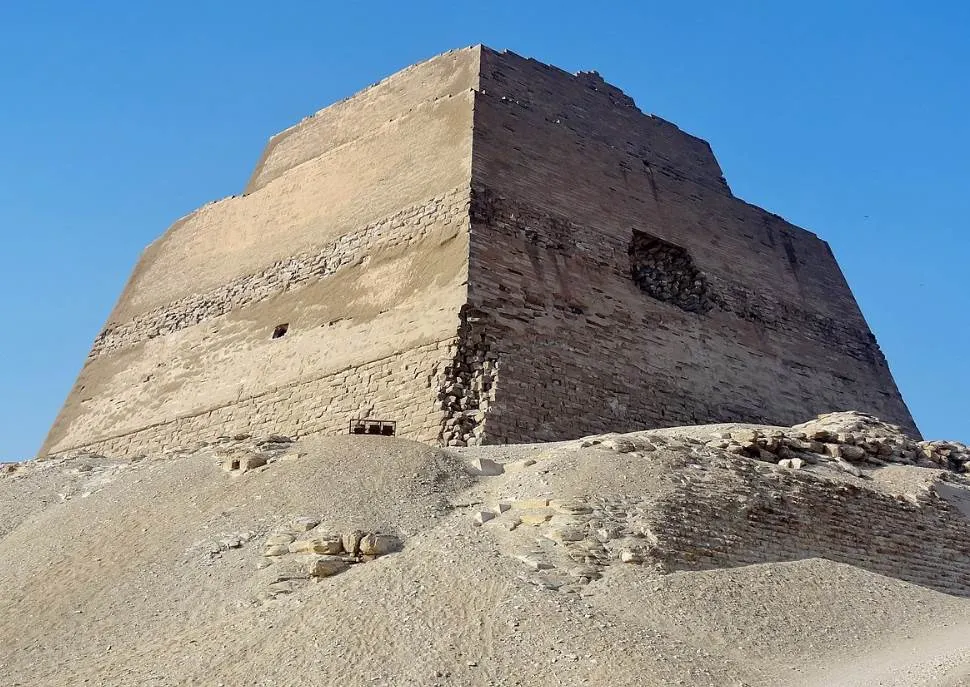
4. Bent Pyramid
The Bent Pyramid was constructed in the 27th century B.C. and was the second project of Pharaoh Sneferu. Egyptologists believe that the collapse of the Meidum Pyramid during the reign of Sneferu resulted in a drastic change in the design. It’s believed to be the first attempt to build a smooth-sided pyramid.
The lower section of the pyramid rises from an angle of 54 degrees. The fear of another collapse made them build the upper section at an angle of just 43 degrees.
This gave the pyramid its intriguing name and why it’s considered to be a transitional structure from step pyramids to smooth-sided pyramids.
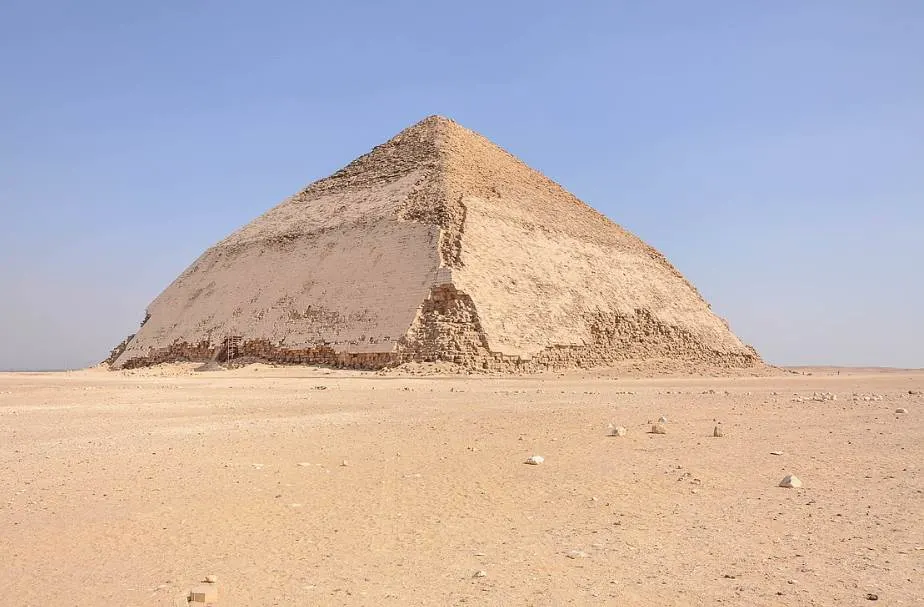
5. Red Pyramid
The Red Pyramid gives its name to the reddish hue of the limestone stones that were used to construct it. It’s the largest of the pyramids at Dahshur and it’s believed to be the first successful attempt to build a smooth-sided pyramid. It was constructed between 2575 and 2551 B.C. and another pyramid by Sneferu.
It looks very similar to the Great Pyramid of Giza and is not that much smaller. It’s the third-largest pyramid in Egypt with a base of 220 meters (722 feet) and a height of 105 meters (344 feet).
Because it was constructed at a relatively shallow angle of 43 degrees (the same angle as the top section of the Bent Pyramid), it looks much smaller than it is.
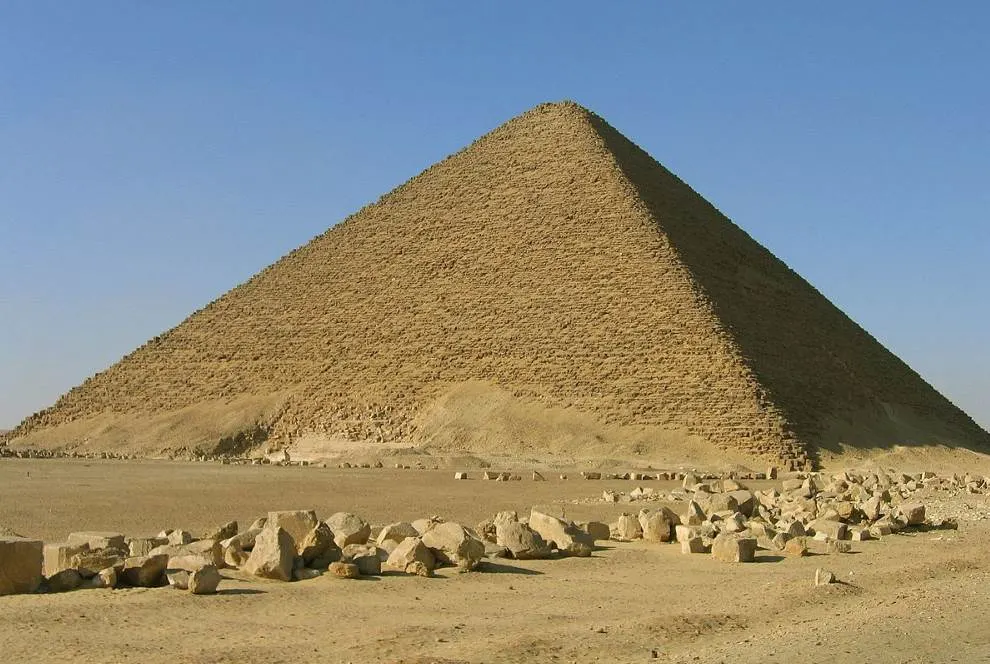
6. Pyramid of Khafre
The Pyramid of Khafre is the second-largest pyramid that was constructed at the Giza Plateau. It was built by the son of Khufu, Pharaoh Khafre, and is often confused with the Great Pyramid of Giza because of the limestone cladding that is still present on the top of the building.
The original height of this structure is believed to have been 143.5 meters (471 feet), a figure that can hold a candle to the average modern-day skyscraper.
It also looks a lot more impressive than the red Pyramid because it features a slope angle of 53°10′ which is substantially steeper than the pyramid at Dahshur.

7. Pyramid of Menkaure
The Pyramid of Menkaure is the third of the 3 immense pyramids in Giza and the smallest of the 3. It was constructed by the son of Khafre and Grandson of Khufu, Pharaoh Menkaure. It’s substantially smaller than its bigger brothers nearby and reached an original height of 65 meters (213 feet) and a square base of 108.5 meters (356 feet).
3 smaller pyramids are located on the southern side of the structure. These are believed to have served as the tomb of the Pharaoh’s Queens and are referred to as G3-a, G3-b, and G3-c.
When the Muslims took over during the Middle Ages, Saladdin’s son named Al-Aziz Uthman had the bright idea to demolish the pyramids. They worked non-stop for 8 months and the result of this endeavor can be seen on the northern slope of the Pyramid of Menkaure.
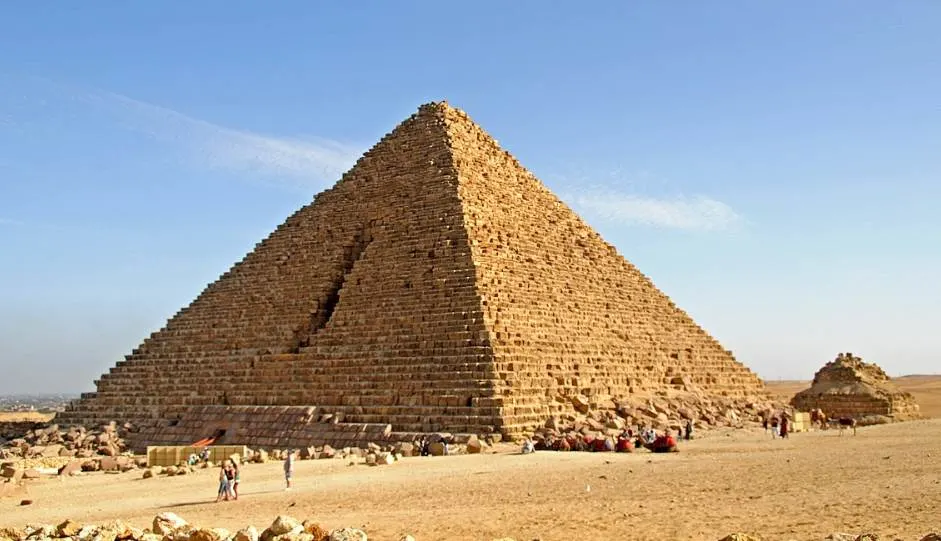
8. Pyramid of Hawara
The Pyramid of Hawara is the main feature of an archaeological site with the same name. It was constructed in the 19th century B.C. by Pharaoh Amenemhat III, the Pharaoh of the 12th dynasty of the Middle Kingdom.
The main building materials of the structure were mudbricks that were constructed around a central system of passageways. This weak building material has resulted in the pyramid laying in complete ruins today.
The pyramid featured multiple intricate trapdoors as entrances, some weighing up to 20 tonnes. Today, these entrances are flooded by the Bahr Yussef, a canal that connects the Bile River to the city of Faiyum, just south-southwest of Cairo.

9. Pyramid of Unas
The Pyramid of Unas is another ruined pyramid that was constructed by the Pharaoh with the same name. Unas was the final Pharaoh of the 5th dynasty of the Old Kingdom.
It’s the smallest of all pyramids that were constructed during the Old Kingdom. It turned out to be one of the most amazing archaeological treasure chests because of the discovery of the so-called “Pyramid Texts” inside the building’s burial chamber.
A total of 283 spells that would serve Pharaoh Unas during his afterlife were inscribed into the walls of this chamber. It was the first time these texts appeared inside a pyramid and they were used for subsequent leaders in the Middle Kingdom, eventually forming the base of the “Book of the Death.”
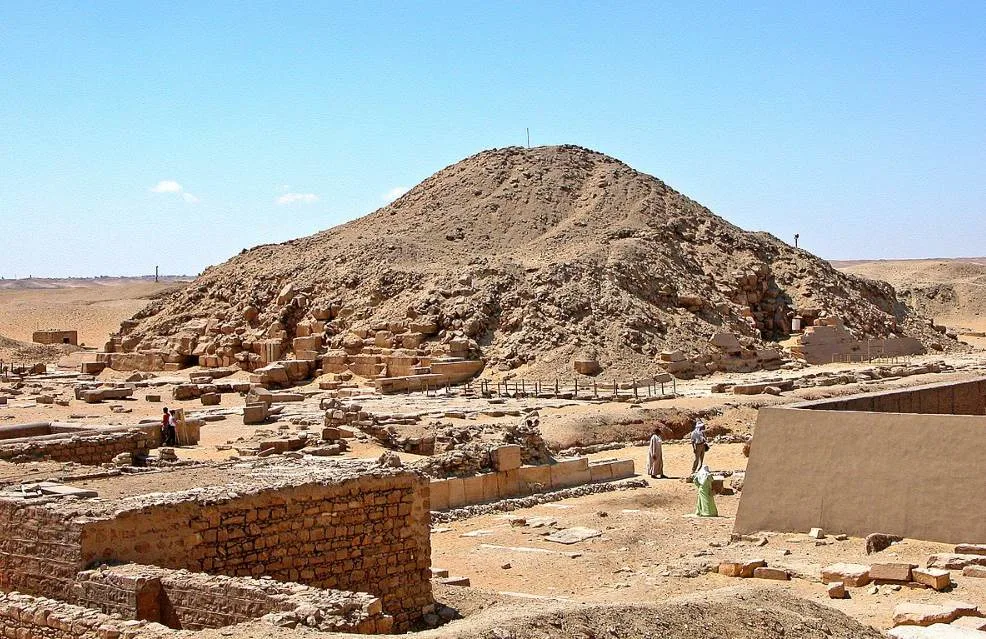
10. Pyramid of Senusret II
The Pyramid of Senusret II was constructed by Pharaoh Senusret II who ruled during the 12th dynasty of the Middle Kingdom. It’s the centerpiece of an archaeological site called “El Lahun,” not too far southeast of the city of Faiyum.
It’s another pyramid that was constructed using mudbricks, resulting in the dilapidated state of the structure today. They also cut parts of the structure out of the rocks to save both time and resources.
Just like all of the other pyramids in Egypt, it was originally encased with white limestones. These were removed during the 19th century for buildings constructed by Pharaoh Ramesses II. This means that this awkward Egyptian pyramid probably shone brightly upon completion.

